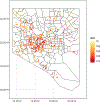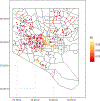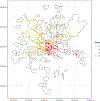Neighborhood Disadvantage and Prostate Tumor Aggressiveness among African American and European American Men
- PMID: 39264110
- PMCID: PMC11614192
- DOI: 10.1158/1055-9965.EPI-24-0450
Neighborhood Disadvantage and Prostate Tumor Aggressiveness among African American and European American Men
Abstract
Background: Studies have identified associations between neighborhood disadvantage (ND), which is more likely to affect African American (AA) individuals, and aggressive prostate cancer. Thus, ND may contribute to prostate cancer disparities. However, it is unknown what ND components drive aggressive disease and whether associations vary by race.
Methods: We evaluated associations between aggressive prostate cancer and four ND metrics-Area Deprivation Index (ADI), validated Bayesian Neighborhood Deprivation Index (NDI), racial isolation (RI) index, and historical redlining, and whether these factors interacted with race, among men with prostate cancer treated at the University of Maryland Greenebaum Comprehensive Cancer Center (2004-2021).
Results: We included 1,458 men (698 European American and 760 AA). AA men were more likely to experience ND. In adjusted models, the ADI, RI, and redlining were significantly associated with aggressive versus nonaggressive prostate cancer overall [ADI, OR for one SD increase = 1.14, 95% confidence interval (CI), 1.00-1.30; RI, OR = 1.27, CI, 1.07-1.51; redlining, OR = 1.77; CI, 1.23-2.56] and among AA men. The NDI was associated with aggressive prostate cancer among AA men (OR = 1.32, 95% credible interval: 1.13-1.57); percent in poverty received the largest importance weight. The ADI (P heterogeneity = 0.002) and NDI (exceedance probability heterogeneity = 98.1%) significantly interacted with race, such that associations were significantly stronger for AA men.
Conclusions: We identified novel significant positive associations for racial segregation and historical redlining with aggressive prostate cancer and significant interactions between ND indices and race.
Impact: Findings inform specific ND components that are associated with aggressive prostate cancer and suggest the ND effect is stronger for AA men, which has implications for interventions to reduce disparities.
©2024 American Association for Cancer Research.
Conflict of interest statement
Figures




Similar articles
-
Neighborhood Disadvantage and Prostate Tumor RNA Expression of Stress-Related Genes.JAMA Netw Open. 2024 Jul 1;7(7):e2421903. doi: 10.1001/jamanetworkopen.2024.21903. JAMA Netw Open. 2024. PMID: 38995644 Free PMC article.
-
Contemporary neighborhood redlining and racial mortgage lending bias and disparities in prostate cancer survival.Cancer. 2025 Apr 15;131(8):e35850. doi: 10.1002/cncr.35850. Cancer. 2025. PMID: 40233138
-
Association of Neighborhood Deprivation With Prostate Cancer and Immune Markers in African American and European American Men.JAMA Netw Open. 2023 Jan 3;6(1):e2251745. doi: 10.1001/jamanetworkopen.2022.51745. JAMA Netw Open. 2023. PMID: 36662526 Free PMC article.
-
Prostate cancer disparities in South Carolina: early detection, special programs, and descriptive epidemiology.J S C Med Assoc. 2006 Aug;102(7):241-9. J S C Med Assoc. 2006. PMID: 17319238 Review.
-
Racial disparity in prostate cancer in the African American population with actionable ideas and novel immunotherapies.Cancer Rep (Hoboken). 2021 Oct;4(5):e1340. doi: 10.1002/cnr2.1340. Epub 2021 Feb 17. Cancer Rep (Hoboken). 2021. PMID: 33599076 Free PMC article. Review.
Cited by
-
Cancer statistics, 2025.CA Cancer J Clin. 2025 Jan-Feb;75(1):10-45. doi: 10.3322/caac.21871. Epub 2025 Jan 16. CA Cancer J Clin. 2025. PMID: 39817679 Free PMC article.
-
Engaging for equity: Lessons from a cross-sector partnership addressing prostate cancer risk in the black community.Res Involv Engagem. 2025 Jun 10;11(1):60. doi: 10.1186/s40900-025-00743-x. Res Involv Engagem. 2025. PMID: 40495230 Free PMC article.
References
-
- Siegel RL, Giaquinto AN, Jemal A. Cancer statistics, 2024. CA: A Cancer Journal for Clinicians. 2024;12–49. - PubMed
-
- Shariff-Marco S, Breen N, Landrine H, Reeve BB, Krieger N, Gee GC, et al. MEASURING EVERYDAY RACIAL/ETHNIC DISCRIMINATION IN HEALTH SURVEYS: how best to ask the questions, in one or two stages, across multiple racial/ethnic groups? 1. Du Bois Review: Social Science Research on Race. 2011;8(1):159–77. - PMC - PubMed
-
- Golub M, Calman N, Ruddock C, Agarwal N, Davis JH, Foley RL Sr, et al. A community mobilizes to end medical apartheid. Progress in Community Health Partnerships: Research, Education, and Action. 2011;5(3):317–25. - PubMed
MeSH terms
Grants and funding
LinkOut - more resources
Full Text Sources
Medical

